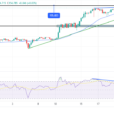The U.S. economy is entering its 4th economic slowdown of this expansion, which has been relatively weak. To be clear, the economy isn’t close to having two quarters of negative real GDP growth which is the baseline definition of a recession. Four slowdowns in one expansion is an unusually high number. The reason for this is because the expansion is 9 years old making, it the 2nd longest since 1854. It’s reasonable to assert that the slowdowns would be close to recessions if during the strong periods of the expansion the economy was growing at the pace it grew at in the previous few decades.
The CBO’s estimate of 3.3% growth in 2018 is supported by the omnibus spending deal and the tax cuts. That level of growth is considered amazing, but it would be considered low growth in the post-WWII period up until the turn of the century. Mentioning the CBO’s estimate is important because most government forecasts are aggressive. The Fed expects 2.7% growth and inflation to meet its 2% target in the next few months which is why it is raising rates at a relatively quick pace for this cycle in 2018. With that said, this hike cycle has been the slowest since 1977.
Rate Of Change Matters
The rate of change is the slope of a line. If the economy was a perfect sine curve, rate of change would tell us everything about the economy because you would know when the peak and trough will be. However, the economy is much more nuanced than that. As we mentioned, there have been 4 slowdowns in this expansion. Each peak doesn’t tell you if a bear market is coming. It only tells you a correction is more likely to occur. If you are a short-term trader, selling any growth peak is obvious because you want to avoid the selloffs. However, if you are a long-term investor who is only trying to get conservative before bear markets, you need to determine if the slowdown signifies that a recession is coming. This is difficult because it comes down to when the rate of change becomes less negative and eventually flips to the positive side. With the yield curve positively sloped and no GDP models showing negative growth in Q1, we’ll lean towards expecting this to be a cyclical slowdown rather than a full recession.












Leave A Comment